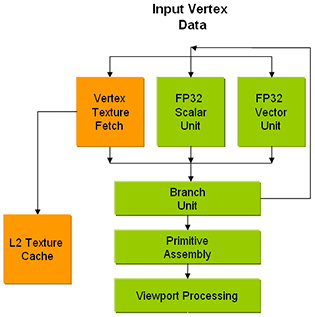 Speaking of complex
transform and lighting effects, the 7800 GPU features full support for the
DirectX Shader Model 3.0 and optimizations for several of the latest advances in
eye candy such as HDR (High Dynamic Range) lighting, subsurface scattering and
nVidia's UltraShadow II technology. These technologies also worked fine with the
6800-series GPUs, but often with a performance hit that substantially reduced
the gaming experience.
Speaking of complex
transform and lighting effects, the 7800 GPU features full support for the
DirectX Shader Model 3.0 and optimizations for several of the latest advances in
eye candy such as HDR (High Dynamic Range) lighting, subsurface scattering and
nVidia's UltraShadow II technology. These technologies also worked fine with the
6800-series GPUs, but often with a performance hit that substantially reduced
the gaming experience.
Vertex Boosting
nVidia has
apparently increased the speed and efficiency of certain vertex shader
operations, resulting in an overall boost to their output. The texture engine
has also undergone an overhaul, with non-specific increases to its speed and
efficiency stated.
nVidia's new transparent Anti-aliasing
technology
With the
introduction of the 7800 GPU, nVidia also debuts two new Anti-Aliasing
technologies, transparency adaptive supersampling and transparency adaptive
multisampling (TRSS and TRMS respectively). These provide a potential solution
to what has long been a thorny image quality problem: The difficulty of
anti-aliasing pixels inside a polygon.
Conventional multi-sampling AA only performs anti-aliasing
on pixels detected to be at the edge of a given polygon, incurring less of a
performance hit but only applying the smoothing effect of AA to the edges of 3D
objects. This is fine for a solid 3D object such as a wall or tree, but what
about grass? Or leaves? Or a chain link fence like the thousands found in the
world's most action packed fence simulator (Half-Life 2)?
The
polygons making up 3D rendered foliage and fences use transparency (alpha)
effects to allow realistic sight lines through them, but this means that the
pixels making up the visible edge of a blade of grass or leaf are not always on
the edge of their polygon, but rather somewhere inside it next to other pixels
which have been made transparent. Multi-sampling AA will not smooth out these
pixels, meaning that textures that use transparencies will always appear to be
jaggy, even in an otherwise glass-smooth 8xAA sampled scene.
The other
common method of Anti-Aliasing, SuperSampling, can solve this problem in a way.
SuperSampling renders each entire frame at a higher resolution then blends the
colour and shade of areas where there is a large amount of difference between
pixels, then re-renders the image at the display resolution. Supersampling does
not care whether it is blending pixels at the edges of polygons or in the middle
of them. The disadvantage though, is that supersampling incurs a huge
performance hit, making it difficult to justify.
nVidia's
TRSS and TRMS AA technologies provide a more elegant solution. Transparency
Adaptive Multi-sampling performs the same AA operations as conventional
multi-sampling does, blending pixels on the edges of polygons. It then goes one
step further by examining each polygon for pixels with alpha (transparency)
information. If it finds them, it applies AA to the pixels adjacent to the
transparent areas too.
As far as
we can tell, Transparency adaptive SuperSampling performs simple multi-sampling
on most of the image as normal, but applies full supersampling to polygons with
alpha pixels in them. This results in higher image quality and a larger
performance hit than TRMS.
In all,
TRSS and TRMS seem like a sensible upgrade to current AA technologies, enabling
better all-around image quality without the performance hit associated with full
supersampled AA. Games like Far Cry and Half-Life 2 should benefit considerably
from nVidia's new tech. We'll see this effect on the next page with a couple of
screen shots.
